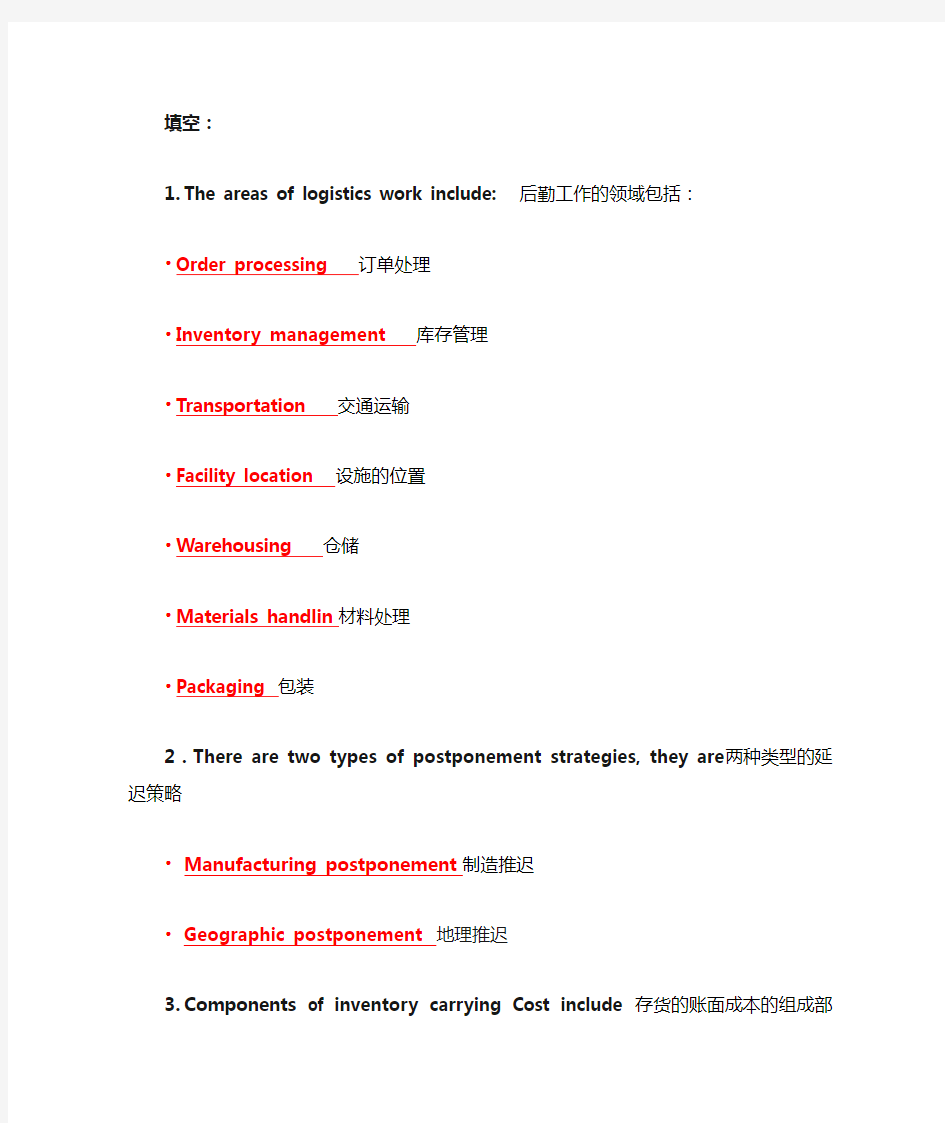
1供应链管理复习题
- 格式:doc
- 大小:73.50 KB
- 文档页数:5


填空:
1.The areas of logistics work include: 后勤工作的领域包括:
•Order processing 订单处理
•Inventory management 库存管理
•Transportation 交通运输
•Facility location 设施的位置
•Warehousing 仓储
•Materials handlin材料处理
•Packaging 包装
2.There are two types of postponement strategies, they are两种类型的延迟策略•Manufacturing postponement制造推迟
•Geographic postponement 地理推迟
ponents of inventory carrying Cost include 存货的账面成本的组成部分
包括
•Capital cost资本成本
•Taxes税
•Insurance保险
•Obsolescence(过时)
•Storage存储
4.The five main Procurement perspectives are 这五个主要采购观点
•Continuous supply连续供应
•Minimize inventory investment减少库存投资
•Quality improvement质量改善
•Supplier devlopment•供应商开发
•Lowest total cost of ownership•最低的总拥有成本
5.Gaps between customers' expectations and supplier performance include:客户之间的期望差距和供应商的表现包括
•Knowledge知识
•Standards标准
•Performance性能
•Communications通信
•Perception•感知
•Satisfaction/Quality满意度/质量
6.Seven factors that drive transportation economics are:运输经济的驱动七因素是
•Distance 距离
•Weight重量
•Density 密度密度密度
•stow-ability 物流能力
•Handling (搬运的难易程度)
•liability责任
•market市场
7.The three pricing strategies include: 三定价策略包括:
•Value-of-Service价值的服务
•Combination pricing 组合定价
•Net-Rate pricing净速率定价
8. The three indicators that measure performances of logistical activities are:这三个指标衡量的后勤活动表现为:
•Availability可用性
•Operational performance 作业绩效
•Service reliability服务的可靠性
9.A firm’s manufacturing competency is based on
•brand power•品牌的力量
•volume 体积(Economy of scale )
•variety 品种(Economy of scope)
•constrains限制
•lead-time交货时间
10 .Three manufacturing strategies include: 三个制造策略包括:
•Make-to-plan请至计划
•Make-to-order请按订单
•Assemble-to-order装配,按订单
名词解释:
1. Postponement:Postponement refers to some of activities in the supply chain that are not performed until customer orders are received.
(延迟:推迟是指在供应链中不执行,直到收到客户订单的一些活动。)
2. logistics:Logistics (management) refers to the responsibility to design and administer system to control movement and geographical position of raw materials, work-in-process, and finished inventories at lowest total cost.
(物流:物流(管理)是指负责设计和管理系统,以控制运动和原材料的地理位置,工作在制品和成品存货以最低的总成本。)
3.Supply chain:The supply chain encompasses all organizations and activities associated with the flow and transformation(转换,转变)of goods from raw materials, through to the end users, as well as associated information and monetary flows。
3.Economy of scale(in transportation):is the cost per unit of weight decreases as the size of a shipment increases.
(规模(运输)经济:是指每单位重量降低为一个装运的大小增加的成本。)
4. Performance cycle:is the elapsed(消逝,耗费)time between the release of a purchase order by a buyer to the receipt of shipment.从发出订货到接收货物花费